水塔水位监测设计.
计控水塔水位检测系统设计..

计算机控制技术论文——基于51单片机的水塔水位检测姓名:张孟娜学号:B10040806系别:电气工程与自动化系专业:自动化基于51单片机的水塔水位检测摘要水塔水位控制系统的基本要求是能够在无人临控的情况下自动进行工作,在水塔中的水位到达水位下限时自动启动电机,给水塔供;在水塔水位达到水位上限的时候自动关闭电机,停止供水。
并能在供水系统出现异常的时候能够出警报,以及时排除故障,随时保证水塔的对外的正常供作用。
因此,这里给出AT89C5l单片机为核心器件的水塔水位检测控制系统仿真设计,实现水位的检测控制、电机故障检测、处理和报警等功能,并在Proteus软件环境下实际仿真。
实验结果表明,该系统具有良好的检测控制功能,可移植性和扩展性强。
关键词:单片机,水位检测,控制系统,仿真Simulation design of water tower water level detection systembased on MCU51ABSTRACTWater towers are basic requirements of the control system can be targeted in one of the circumstances, be in the water under the water tanks arrive within automatically start motor,give towers for,in the upper reaches of the water level of towers,when to stop water automatically closed motor.And in the water supply system of the abnormal warning,and can when faults,keep the normal supply of foreign towers.A water tower water level detection system is designed in this paper. This system can realize water source detection, motor failure detection, processing and alarming. The independent detection circuit can realize the superelevation, the low warning water level can report to the police and superelevation warning water level process. On the principle of interface circuits, software design is the corresponding flow chart and the corresponding compilation of the main program, at the same time carries on the simulation with the proteus software. The result indicates that this system features good examination control function, the probability and extendibility.KEY WORDS: chip microcomputer,water level examination,control system,simulation目录第1章绪论----------------------------------------------------------------11.1 选题的背景与意义---------------------------------------------11.1.1 选题背景--------------------------------------------------11.1.2 选题意义--------------------------------------------------11.1.3 控制原理--------------------------------------------------2第2章系统总体设计---------------------------------------------------32.1 方案的选择-----------------------------------------------------32.2 系统总体设计(要求有框图)------------------------------3第3章硬件设计----------------------------------------------------------53.1 硬件选型---------------------------------------------------------53.2 引脚功能---------------------------------------------------------53.3 硬件电路设计(按模块)-------------------------------------53.3.1水位检测接口电路------------------------------------错误!未定义书签。
水塔水位控制系统PLC设计(技术部)

水塔水位控制系统设计、水塔水位控制系统硬件设计 、水塔水位控制系统设计要求水塔水位控制装置如图所示图 水塔水位控制装置水塔水位的工作方式:当水池液位低于下限液位开关,此时为,水阀打开(为),开始往水池里注水,定时器开始定时,秒以后,若水池液位没有超过水池下限液位开关时(还不为),则系统发出报警(阀指示灯闪烁),表示阀没有进水,出现故障。
若系统正常,此时水池下限液位开关为,表示水位高于下限水位。
当水位液面高于上限水位,则为,阀关闭(为)。
当为时,且水塔水位低于水塔下限水位时(水塔下限水位开关为),电机开始工作,向水塔供水,当为时,表示水塔水位高于水塔下限水位。
当水塔液面高于水塔上限水位时(水塔上限水位开关为),电机停止。
(注:当水塔水位低于下限水位,同时水池水位也低于下限水位时,水泵不能启动) 水塔水位控制系统主电路水塔水位控制系统主电路如图所示:M 3~L1L2L3SQ FUKMFR图 水塔水位控制系统主电路、接口分配水塔水位控制系统的接口分配如表所示。
表 水塔水位控制系统的接口分配表符号地址 绝对地址 数据类型说明表示水塔的水位上限,表示水塔的水位下限,表示水池水位上限,表示水池水位下限,为抽水电机,为水阀。
水塔上限水位 水塔下限水位 水池上限水位 水池下限水位 控制开关 水阀 抽水电机 水池下限指示灯 水池上限指示灯 水塔下限指示灯 水塔上限指示灯 报警指示灯 、水塔水位控制系统的接线图这是一个单体控制小系统,没有特殊的控制要求,它有个开关量,开关量输出触点数有个,输入、输出触点数共有个,只需选用一般中小型控制器即可。
据此,可以对输入、输出点作出地址分配,水塔水位控制系统的接线图如图所示。
1M~220VI0.0I0.1I0.2I0.3I0.4Q0.1Q0.2Q0.3Q0.4Q0.5Q0.6Q0.7KMI KMSB 传感器1传感器2传感器3传感器4水池下位指示灯水池上位指示灯水塔下位指示灯水塔下位指示灯报警指示灯图 水塔水位控制系统的接线图、水塔水位控制系统软件设计 程序流程图水塔水位控制系统的控制流程图,根据设计要求,控制流程图如图所示。
水塔智能水位控制系统设计设计
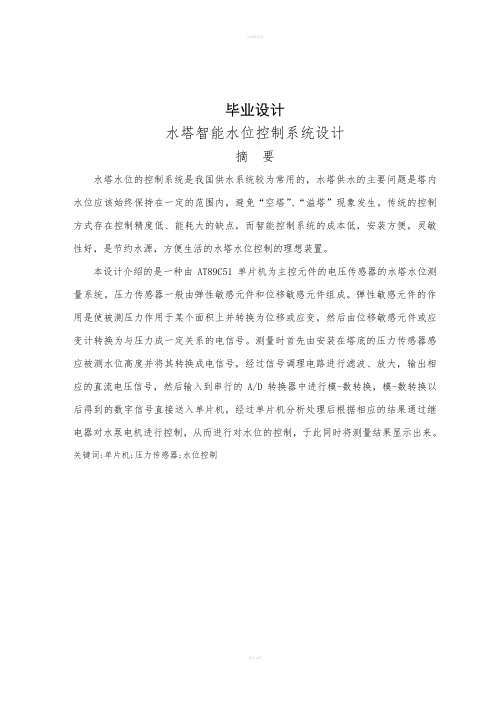
毕业设计水塔智能水位控制系统设计摘要水塔水位的控制系统是我国供水系统较为常用的,水塔供水的主要问题是塔内水位应该始终保持在一定的范围内,避免“空塔”、“溢塔”现象发生。
传统的控制方式存在控制精度低、能耗大的缺点,而智能控制系统的成本低,安装方便,灵敏性好,是节约水源,方便生活的水塔水位控制的理想装置。
本设计介绍的是一种由AT89C51单片机为主控元件的电压传感器的水塔水位测量系统。
压力传感器一般由弹性敏感元件和位移敏感元件组成。
弹性敏感元件的作用是使被测压力作用于某个面积上并转换为位移或应变,然后由位移敏感元件或应变计转换为与压力成一定关系的电信号。
测量时首先由安装在塔底的压力传感器感应被测水位高度并将其转换成电信号,经过信号调理电路进行滤波、放大,输出相应的直流电压信号,然后输入到串行的A/D转换器中进行模-数转换,模-数转换以后得到的数字信号直接送入单片机,经过单片机分析处理后根据相应的结果通过继电器对水泵电机进行控制,从而进行对水位的控制,于此同时将测量结果显示出来。
关键词:单片机;压力传感器;水位控制Water tower’s intelligent water leve l controlsystem designAbstractWater tower’s water level control system is relatively commonly used in the Chinese water supply system; the main problem of the water tower’s water supply is the water level in the water tower should always remain within a certain range,to avoid the “empty tower”, “overflow” tower phenomenon. Traditional control mode exist the shortcoming of control precision low, energy consumption big, and the cost of intelligent control system is low, easy installation, and good sensitivity, it is the ideal device to save water, to facilitate the life of the water tower’s water level control.This design introduces is AT89C51 microcontroller as a master component of the voltage sensor of the water tower’s water level measurement system. The pressure sensor is generally composed by the elastic sensing element and displacement sensitive components. The role of the elastic sensing element is to make tested pressure in a certain area and converted to displacement or strain, then the displacement sensitive components or strain gauge is converted to a certain relationship with the pressure of the electrical signals. First the pressure sensor installed in the bottom of the sensor measured the height of water level measurements and converted into electricalsignals, after the signal conditioning circuit filtering,amplification, output DC voltage signal, the enter the serial A/D converter for analog-digital conversion, after analog-digital conversion, the digital signal directly into the microcontroller, after microprocessor analysis processing according to the results through a relay to control the pump motor, thus control of water level, at the same time the measurement results are displayed.Key words: SCM; pressure sensor; water level control目录摘要 (I)Abstract (II)第1章绪论 (1)1.1水塔水位的产生背景 (1)1.2水塔水位的研究现状 (1)1.3单片机的发展趋势及应用 (3)1.4设计中水泵的工作方式 (3)1.5本次设计的内容 (4)第2章方案论证 (5)2.1 采样模块 (6)2.1.1 继电器开关式 (6)2.1.2 压力传感器 (7)2.2 模数转换 (7)2.2.1 AD转换器的分类 (7)2.2.2 串并行AD转换器的选取 (7)2.2.3 AD转换器芯片型号的选取 (8)2.3 控制模块 (8)2.3.1 继电器的介绍 (8)2.3 显示模块 (10)2.3.1 LED显示器 (10)2.3.2 LCD显示器 (10)第3章硬件方案设计 (12)3.1 单片机AT89C51 (12)3.1.1 主要特性 (13)3.1.2 管脚说明 (14)3.2 压力传感器 (18)3.2.1 技术参数 (18)3.2.2 特点 (19)3.2.3 工作原理与电路图 (20)3.3 A/D转换器TLC0834 (20)3.3.1 TLC0834主要特点 (20)3.3.2 工作特点 (21)3.3.3 引脚功能 (22)3.4 LCD显示器 (23)3.4.1 1602显示器主要技术参数 (24)3.4.2 1602LCD特性 (24)3.4.3引脚功能 (24)3.5 继电器输出 (25)3.6 报警 (26)3.7 电子狗及复位 (27)3.7.1 X25045引脚图 (27)3.7.2复位电路 (28)3.7.3 单片机与电子狗、复位电路图 (28)3.8稳压电源 (29)3.8.1 稳压电源工作原理 (29)3.8.2 LM7805 (30)3.9时钟电路 (31)第4章软件方案设计 (33)4.1 水塔水位控制主程序 (33)4.2 中断报警程序 (34)4.3 看门狗程序 (35)第5章总结 (37)参考文献 (38)致谢 (39)附录 (40)第1章绪论1.1水塔水位的产生背景从古至今,洗衣做饭、灌溉农田,水资源一直都在人们日常生活和生产中起着至关重要的作用,突然断水,不仅会给人们的生活带来大大的不便,而且如果长时间缺水,则很有可能造成严重的自然灾害甚至更大的损失。
水塔水位自动控制系统设计.
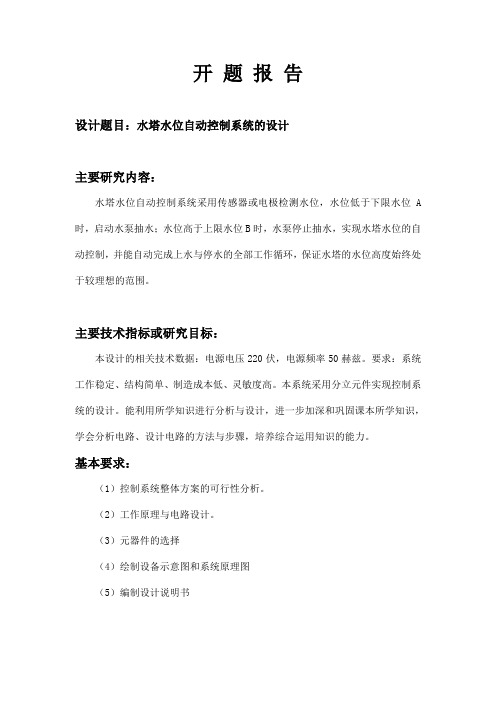
开题报告设计题目:水塔水位自动控制系统的设计主要研究内容:水塔水位自动控制系统采用传感器或电极检测水位,水位低于下限水位A 时,启动水泵抽水;水位高于上限水位B时,水泵停止抽水,实现水塔水位的自动控制,并能自动完成上水与停水的全部工作循环,保证水塔的水位高度始终处于较理想的范围。
主要技术指标或研究目标:本设计的相关技术数据:电源电压220伏,电源频率50赫兹。
要求:系统工作稳定、结构简单、制造成本低、灵敏度高。
本系统采用分立元件实现控制系统的设计。
能利用所学知识进行分析与设计,进一步加深和巩固课本所学知识,学会分析电路、设计电路的方法与步骤,培养综合运用知识的能力。
基本要求:(1)控制系统整体方案的可行性分析。
(2)工作原理与电路设计。
(3)元器件的选择(4)绘制设备示意图和系统原理图(5)编制设计说明书摘要在工农业生产过程中,经常需要对水位进行测量和控制。
水位控制在日常生活中应用也相当广泛,比如水塔、地下水、水电站等情况下的水位控制。
而水位检测可以有很多种实现方法,如机械控制、逻辑电路控制、机电控制等。
本文采用分立元件实现控制系统的设计,在水箱上安装一个自动检测水位装置,利用水的导电性,连续的全天候的测量水位的变化,把测量的水位变化转换成相应的电信号,由逻辑电路进行处理,完成相应的动作,使水位保持在适当的位置。
关键词水位控制分立式元件控制目录1引言 (1)2系统方案 (2)2.1 概述 (2)2.2 系统组成 (3)2.2.1系统工作原理框图 (3)2.2.2功能原理 (3)3单元电路设计 (4)3.1系统电源电路设计 (4)3.1.1三端集成稳压器的介绍 (4)3.1.2电源电路工作过程 (6)3.2液位传感器电路设计 (6)3.3报警显示电路设计 (7)4系统电路设计 (8)4.1系统主干电路 (8)4.2系统手动电路 (9)4.3系统自动电路 (9)5系统运行总体过程 (12)6元件清单 (13)附录 (18)总结 (19)参考文献 (20)致谢 (21)1.引言随着我国经济和科学技术的飞速发展,我国各个领域的现代化建设都取得可喜的成果:尤其在中国的广大城市中,可以说现代化的进程已经赶上了发达国家,这一点是我们华夏儿女几代人的梦想。
水塔水位控制毕业设计
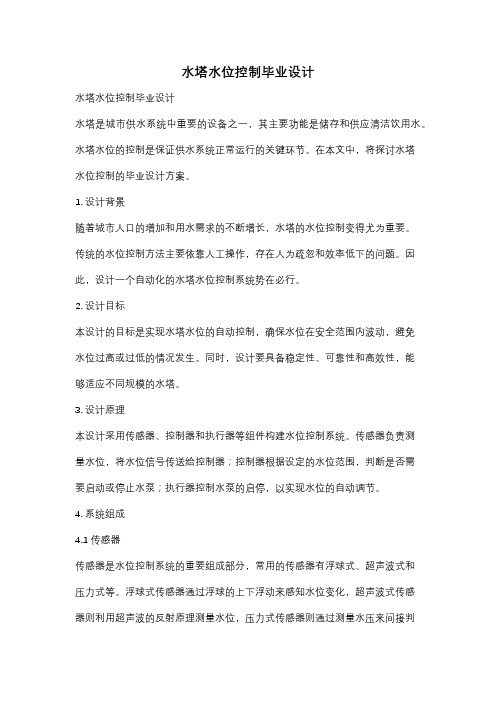
水塔水位控制毕业设计水塔水位控制毕业设计水塔是城市供水系统中重要的设备之一,其主要功能是储存和供应清洁饮用水。
水塔水位的控制是保证供水系统正常运行的关键环节。
在本文中,将探讨水塔水位控制的毕业设计方案。
1. 设计背景随着城市人口的增加和用水需求的不断增长,水塔的水位控制变得尤为重要。
传统的水位控制方法主要依靠人工操作,存在人为疏忽和效率低下的问题。
因此,设计一个自动化的水塔水位控制系统势在必行。
2. 设计目标本设计的目标是实现水塔水位的自动控制,确保水位在安全范围内波动,避免水位过高或过低的情况发生。
同时,设计要具备稳定性、可靠性和高效性,能够适应不同规模的水塔。
3. 设计原理本设计采用传感器、控制器和执行器等组件构建水位控制系统。
传感器负责测量水位,将水位信号传送给控制器;控制器根据设定的水位范围,判断是否需要启动或停止水泵;执行器控制水泵的启停,以实现水位的自动调节。
4. 系统组成4.1 传感器传感器是水位控制系统的重要组成部分,常用的传感器有浮球式、超声波式和压力式等。
浮球式传感器通过浮球的上下浮动来感知水位变化,超声波式传感器则利用超声波的反射原理测量水位,压力式传感器则通过测量水压来间接判断水位。
根据实际需求选择合适的传感器。
4.2 控制器控制器是水位控制系统的核心部件,负责接收传感器信号并进行处理。
控制器需要具备高精度、高稳定性和高可靠性,能够实时监测水位变化,并根据预设的水位范围做出相应的控制决策。
4.3 执行器执行器是控制器的输出部分,负责根据控制器的指令控制水泵的启停。
水泵的启停需要根据水位的高低来决定,当水位过低时启动水泵,当水位过高时停止水泵。
5. 系统设计在系统设计中,需要考虑传感器的安装位置、控制器的算法设计和执行器的控制方式。
传感器应安装在水塔内部,以便准确测量水位。
控制器的算法设计可以采用PID控制或模糊控制等方法,以实现对水位的精确控制。
执行器可以采用继电器或可编程逻辑控制器等方式,实现对水泵的启停控制。
水塔水位控制设计

摘要单片机自20世纪70年代问世以来,以其极高的性价比,受到人们的重视和关注,应用广、发展快。
而MCS-51单片机是各单片机中最为典型和最具代表性的一种。
本次设计以80C51芯片为核心,辅以必要的外围电路,设计了一个简易的水塔水位控制系统,它由5V直流电源供电。
在硬件方面,除了CPU外,使用了2732芯片对80C51的 ROM进行4K扩展,并且使用74LS07芯片对外部电路驱动。
软件方面采用汇编语言编程,整个水塔水位控制系统能根据水塔水位的高低来决定水泵电机的运转状态,并且在发生故障时由外部电路的LED发光管点亮报警。
通过这次设计让我更深入了解单片机基本电路和汇编语言编程的基本方法,从而锻炼了我学习、设计和开发软、硬件的能力。
关键词:水位控制单片机.一、引言:实验证明,纯净水几乎是不导电的,但自然界存在的以及人们日常使用的水都会含有一定的Mg2+、Ca2+等离子,它们的存在使水导电。
本控制装置就是利用水的导电性完成的二、设计方案及原理:如图1所示,虚线表示允许水位变化的上下限。
在正常情况下,应保持水位在虚线范围之内。
为此,在水塔的不同高度安装了3根金属棒,以感知水位变化情况。
图1 水塔水位控制原理图图中虚线表示允许水位变化的上下限。
在正常情况下,应保持水位在虚线范围之内。
为此,在水塔内的不同高度安装3根金属棒,以感知水位的变化情况。
其中A棒处于水塔底部,C棒处于上限水位上,B棒处于下限水位上。
A棒接+5V电源,B棒、C棒各通过一个电阻与地相连。
水塔由电机带动水泵供水,单片机控制电机转动以达到对水位控制的目的。
供水时,水位上升,当达到上限时,由于水的导电作用,B、C棒连通+5V,因此,b、c两端均为“1”态,这时应停止电机和水泵的工作,不再给水塔供水。
当水位降到下限时,B、C棒都不能与A棒导通,因此b、c两端均为“0”状态。
这时应启动电机,带动水泵工作,给水塔供水。
当水位处于上下限之间时,B棒与A棒导通,因C棒不能与A棒导通,b端为“1”状态,c端为“0”状态。
水塔水位控制系统设计毕业设计
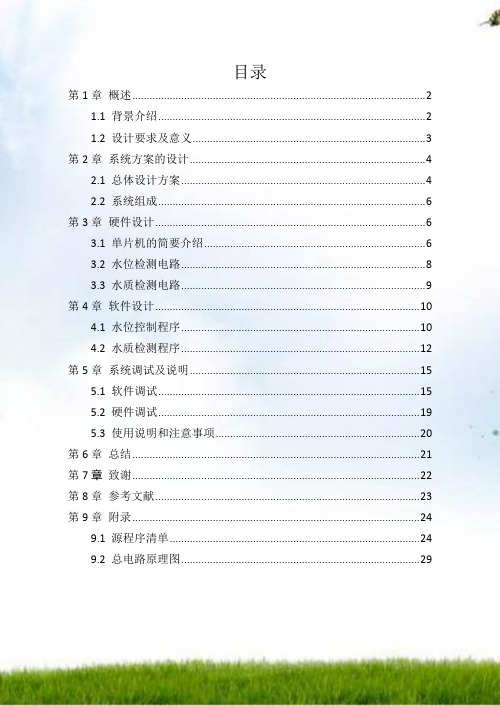
目录第1章概述 (2)1.1 背景介绍 (2)1.2 设计要求及意义 (3)第2章系统方案的设计 (4)2.1 总体设计方案 (4)2.2 系统组成 (6)第3章硬件设计 (6)3.1 单片机的简要介绍 (6)3.2 水位检测电路 (8)3.3 水质检测电路 (9)第4章软件设计 (10)4.1 水位控制程序 (10)4.2 水质检测程序 (12)第5章系统调试及说明 (15)5.1 软件调试 (15)5.2 硬件调试 (19)5.3 使用说明和注意事项 (20)第6章总结 (21)第7章致谢 (22)第8章参考文献 (23)第9章附录 (24)9.1 源程序清单 (24)9.2 总电路原理图 (29)第1章概述1.1 背景介绍随着科学技术的发展, 单片机作为嵌入式微控制器在工业测控系统, 智能仪器和家用电器中得到广泛使用。
在实时检测和自动控制的单片机使用系统中,单片机往往是作为一个核心部件来使用。
水塔水位控制系统的基本要求是能够在无人监控的情况下自动进行工作, 在水塔中的水位到达水位下限时自动启动电机, 给水塔供水;在水塔水位达到水位上限的时候自动关闭电机, 停止供水。
并能在供水系统出现异常的时候能够发出警报, 以及时排除故障, 随时保证水塔的对外的正常供水作用。
水塔是在日常生活和工业使用中经常见到的蓄水装置, 通过对其水位的控制对外供水以满足需要, 其水位控制具有普遍性。
不论社会经济如何飞速, 水在人们正常生活和生产中起着重要的作用。
一旦断了水, 轻则给人民生活带来极大的不便, 重则可能造成严重的生产事故及损失, 从而对供水系统提出了更高的要求, 满足及时、准确、安全充足的供水。
如果仍然使用人工方式, 劳动强度大, 工作效率低, 安全性难以保障, 由此必须进行自动化控制系统的改造。
从而实现提供足够的水量、平稳的水压、水塔水位的自动控制有设计低成本、高实用价值的控制器。
该设计采用分立的电路实现超高、低警戒水位处理,实现自动控制,而达到节能的目的,提高了供水系统的质量。
水位自动检测与控制系统的设计

1 引言1.1 探讨背景在社会经济飞速发展的今日,水在人们生活和生产中起着越来越重要的作用。
一旦断水,轻则给人民生活带来极大的不便,重则可能造成重大的生产事故及损失。
因此,对水位的自动检测及限制的探讨,有着极其重要的地位。
任何时候都能供应足够的水量,平稳的水压,合格的水质,是对供水系统的基本要求。
就目前而言,多数工业生活供水系统,都接受水塔,层顶水箱等基本储水设备,由一级二级水泵从地下市政水管补给,因此如何建立一个牢靠平安又利于维护的给水系统是值得我们探讨的课题。
现今社会,自动扮装置无所不在,在限制技术需求的推动下,限制理论本身也取得了显著的进步。
水塔水位的监测和限制,再也不须要人工进行操作。
实践证明,自动化操作,具有不行替代的应用价值。
在工农业生产以及日常生活应用中,常常会须要对容器中的液位(水位)进行自动限制。
比如自动限制水箱、水池、水槽、锅炉等容器中的蓄水量,生活中抽水马桶的自动补水限制、自动电热水器、电开水机的自动进水限制等。
虽然各种水位限制的技术要求不同,精度不同,但基本的限制原理都可以归纳为一般的反馈限制方式,就是利用传感器对于信号的供应通过单片机对数码显示、电机限制、报警限制部分的限制[1]。
本设计从分析水塔水位报警器的原理和设计方法入手,主要基于单片机的硬件电路和语言程序设计,实现一种能够实现水位自动限制、具有自动爱惜、自动声光报警功能的限制系统。
本限制系统由A/D转换部分、单片机限制部分、数码显示部分、电机驱动部分、电机限制部分等构成。
这是个简洁而灵敏的监测报警电路,操作简洁,接通电源即可工作。
因为大部分电路接受数字电路,所以本水位监测报警器还具有耗能低、精确性高的特点。
该系统设计新颖、简易,灵敏度高,工作稳定,能够自动检测和显示当前水位、凹凸水位报警等功能水位自动限制电路是通过水位传感器将水位高度转换为0~10V的直流电压,再经过A/D转换后,将转换所得的数字量送入单片机进行处理来达到对水位进行自动限制的目的。
水塔液位检测及控制系统设计 (2)

摘要水塔液位检测及控制系统利用LabVIEW软件自动检测并控制水塔的液位,通过传感器利用传感器及继电器获取水位信息,我们通过LabVIEW控制系统前面板了解情况。
整个系统采用模块化设计,能够顺利实现题目要求的各项功能。
测试结果符合题目要求,成功的实现了我们的设计目标。
【关键词】传感器;LabVIEW软件;继电器。
目录第一章课题背景 (1)第二章水位检测控制原理 (2)2.1 控制方案 (2)2.2 控制的实现 (2)2.2.1水位信号的获取 (2)2.2.2 信号的采集与输出转换 (3)2.2.3 LabVIEW功能要求 (3)2.2.4 信号输出与注、排水功能的实现 (3)第三章LabVIEW控制程序的设计 (5)3.1 前面板介绍 (5)3.2 程序框图原理 (6)3.2.1 信号采集部分 (6)3.2.2 工作状态显示部分 (7)3.2.3 程序逻辑部分 (7)3.2.4 信号输出部分 (10)第四章硬件系统的选择及搭建 (10)4.1 硬件的选择 (10)4.1.1传感器的选择 (10)4.1.2 电机的选择 (12)4.1.3 电磁阀的选择 (13)4.1.4 继电器的选择 (13)4.1.5 信号采集卡的选择 (14)4.1.6 外部放大电路的制作 (14)4.2 硬件的连接 (15)第五章系统测试完善 (19)5.1 系统测试 (19)5.1.1手动水位控制调试 (19)5.1.2区间水位控制调试 (20)5.1.3精确水位控制调试 (22)5.2系统完善 (23)参考文献 (24)致谢 (25)第一章课题背景水塔的应用十分广泛,现今存在的水塔液位控制主要有机械式、电气式、光电、电磁式等,这些控制虽能满足控制水位的要求,但是自动化程度都不够高,本设计系统利用LabVIEW软件自动检测并控制水塔的液位,操作人员只需在LabVIEW控制程序中设定好相关的参数即可实现对水塔液位系统的实时精确控制。
水塔水位监测设计.
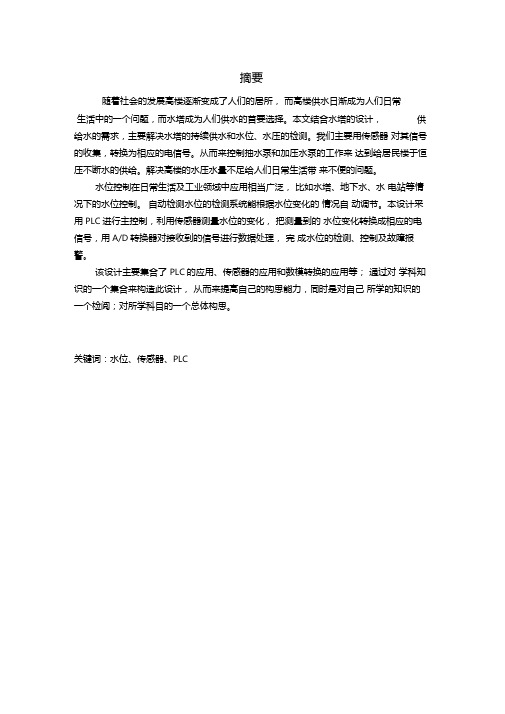
摘要随着社会的发展高楼逐渐变成了人们的居所,而高楼供水日渐成为人们日常生活中的一个问题,而水塔成为人们供水的首要选择。
本文结合水塔的设计,供给水的需求,主要解决水塔的持续供水和水位、水压的检测。
我们主要用传感器对其信号的收集,转换为相应的电信号。
从而来控制抽水泵和加压水泵的工作来达到给居民楼于恒压不断水的供给。
解决高楼的水压水量不足给人们日常生活带来不便的问题。
水位控制在日常生活及工业领域中应用相当广泛,比如水塔、地下水、水电站等情况下的水位控制。
自动检测水位的检测系统能根据水位变化的情况自动调节。
本设计采用PLC进行主控制,利用传感器测量水位的变化,把测量到的水位变化转换成相应的电信号,用A/D转换器对接收到的信号进行数据处理,完成水位的检测、控制及故障报警。
该设计主要集合了PLC的应用、传感器的应用和数模转换的应用等;通过对学科知识的一个集合来构造此设计,从而来提高自己的构思能力,同时是对自己所学的知识的一个检阅;对所学科目的一个总体构思。
关键词:水位、传感器、PLCAbstractWith the development of building society gradually into people's homes and build in gs, water supply is beco ming a problem in people's daily life, and becomes the first choice of the people of water tower. In this paper, combined with the tower desig n, the water supply dema nd, mainly to solve the con ti nu ous water supply and water level detection, the pressure of the water tower. We mainly used to collect sen sor to the sig nal, is con verted to a corresp onding electrical sig nal. I n order to con trol the water pump and the pressure pump to work to give reside nts in con sta nt pressure water supply. To solve the problem of pressure water tower to people's daily life inconvenient problem.Water level con trol is widely used in daily life and in dustrial fields, such as the water level of the water tower, water, hydropower station under the condition of control. Automatic detection system of water level can be automatically adjusted accord ing to water level cha nges. This desig n uses PLC for the main con trol, sen sor using the change water level measurement, the measured water level to change into a corresponding electrical signal by A/D converter, the received signal and data process ing, the water level detecti on, con trol and fault alarm completed.The design of the main set of applications and data model application, sensor PLC conv ersi on applicati ons; through a set of subject kno wledge to con struct this desig n, so as to improve their thi nking ability, also is a parade of his kno wledge; to have an overall idea of the subjectKeywords: water level, sen sor, PLC目录第一章传感器的概述 (1)第一节传感器的的作用与功能 (1)第二节传感器的分类 (1)第三节传感器的主要静态性能指标 (2)第四节水位传感器的原理及应用 (3)第二章PLC可编程控制器的介绍 (5)第一节可编程控制器 (5)第二节PLC的结构及其各部分的作用............................ 错误!未定义书签。
实验11 水塔水位控制
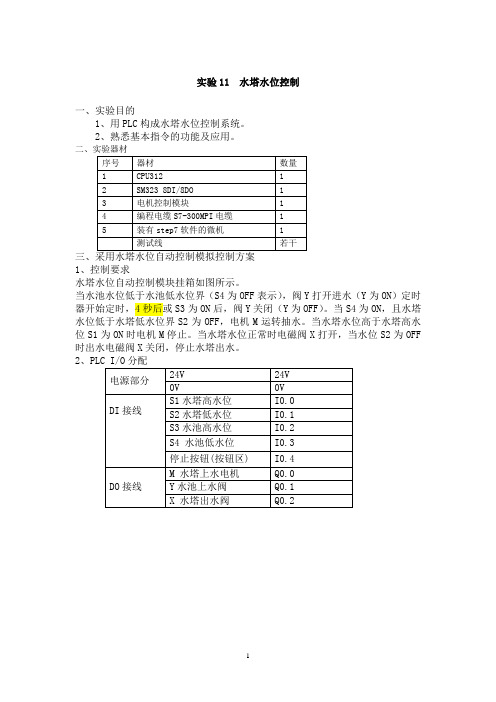
实验11 水塔水位控制
一、实验目的
1、用PLC构成水塔水位控制系统。
2、熟悉基本指令的功能及应用。
1、控制要求
水塔水位自动控制模块挂箱如图所示。
当水池水位低于水池低水位界(S4为OFF表示),阀Y打开进水(Y为ON)定时器开始定时,4秒后或S3为ON后,阀Y关闭(Y为OFF)。
当S4为ON,且水塔水位低于水塔低水位界S2为OFF,电机M运转抽水。
当水塔水位高于水塔高水位S1为ON时电机M停止。
当水塔水位正常时电磁阀X打开,当水位S2为OFF 时出水电磁阀X关闭,停止水塔出水。
2、
3、实验步骤
(1)按控制要求和所确定的I/O分配接线
(2)按控制要求和所确定的I/O分配编写PLC应用程序。
(3)完成PLC与实验模块的外部电路连接,然后通电运行:
四、实验报告要求
1、画出PLC I/O端口和电源接线图。
2、编写程序梯行图。
3、整理出运行和监视程序时出现的现象。
水塔检测控制设计
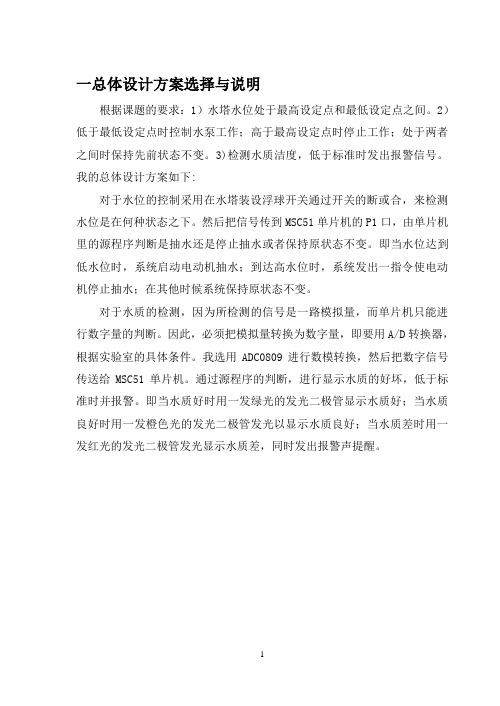
一总体设计方案选择与说明根据课题的要求:1)水塔水位处于最高设定点和最低设定点之间。
2)低于最低设定点时控制水泵工作;高于最高设定点时停止工作;处于两者之间时保持先前状态不变。
3)检测水质洁度,低于标准时发出报警信号。
我的总体设计方案如下:对于水位的控制采用在水塔装设浮球开关通过开关的断或合,来检测水位是在何种状态之下。
然后把信号传到MSC51单片机的P1口,由单片机里的源程序判断是抽水还是停止抽水或者保持原状态不变。
即当水位达到低水位时,系统启动电动机抽水;到达高水位时,系统发出一指令使电动机停止抽水;在其他时候系统保持原状态不变。
对于水质的检测,因为所检测的信号是一路模拟量,而单片机只能进行数字量的判断。
因此,必须把模拟量转换为数字量,即要用A/D转换器,根据实验室的具体条件。
我选用ADC0809进行数模转换,然后把数字信号传送给MSC51单片机。
通过源程序的判断,进行显示水质的好坏,低于标准时并报警。
即当水质好时用一发绿光的发光二极管显示水质好;当水质良好时用一发橙色光的发光二极管发光以显示水质良好;当水质差时用一发红光的发光二极管发光显示水质差,同时发出报警声提醒。
二系统结构框图与工作原理系统结构框图:系统工作原理:在启动系统初始化后,经单片机的反复扫描检测水位和水质,对水为和水质进行判断。
当水位到达最低点时,浮球开关断开即输出一低电平。
通过信息传递到单片机后,单片机判断并发出一指令,启动电动机抽水。
随着水位的升高,低水位处的浮球开关先闭合。
因为水位没有到达最高水位,因此经单片机判断后保持原状态即继续抽水。
随着时间的推移,水逐渐的增多,当水位达到最高水位后,浮球开关闭合后,向单片机传送一高电平,经单片机判断后发出一指令,电动机停止抽水。
单片机继续工作扫描,在水位没有达到最低点时,电动机保持原状态不变。
即如果电动机在抽水就继续抽水,直到到达高水位后才停止抽水;如果电动机在停止工作状态,则保持不抽水状态,只有等到水位达到最低水位时,电动机才启动抽水。
水塔水位水温监测系统的设计
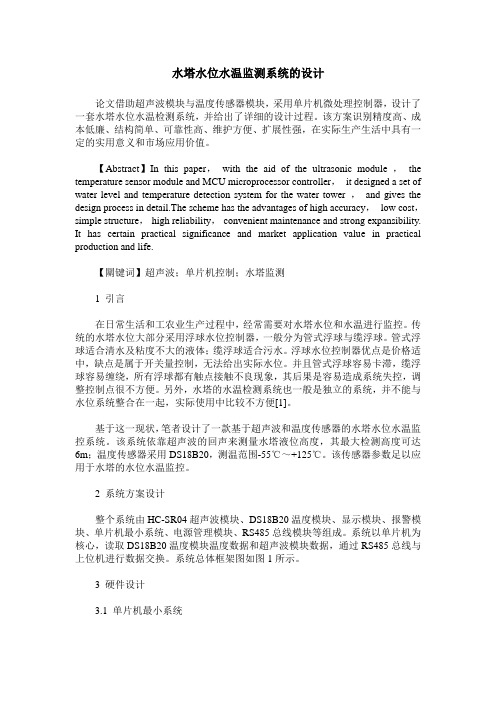
水塔水位水温监测系统的设计论文借助超声波模块与温度传感器模块,采用单片机微处理控制器,设计了一套水塔水位水温检测系统,并给出了详细的设计过程。
该方案识别精度高、成本低廉、结构简单、可靠性高、维护方便、扩展性强,在实际生产生活中具有一定的实用意义和市场应用价值。
【Abstract】In this paper,with the aid of the ultrasonic module ,the temperature sensor module and MCU microprocessor controller,it designed a set of water level and temperature detection system for the water tower ,and gives the design process in detail.The scheme has the advantages of high accuracy,low cost,simple structure,high reliability,convenient maintenance and strong expansibility. It has certain practical significance and market application value in practical production and life.【關键词】超声波;单片机控制;水塔监测1 引言在日常生活和工农业生产过程中,经常需要对水塔水位和水温进行监控。
传统的水塔水位大部分采用浮球水位控制器,一般分为管式浮球与缆浮球。
管式浮球适合清水及粘度不大的液体;缆浮球适合污水。
浮球水位控制器优点是价格适中,缺点是属于开关量控制,无法给出实际水位。
并且管式浮球容易卡滞,缆浮球容易缠绕,所有浮球都有触点接触不良现象,其后果是容易造成系统失控,调整控制点很不方便。
水塔水位PID控制系统设计、设计图

水塔水位PID控制系统设计摘要供水是一个关系国计民生的重要产业。
随着社会的发展和人民生活水平的提高,对城市供水提出了更高的要求,有一个水箱需要维持一定的水位,该水塔里的水以变化的速度流出。
这就需要有一个输入控制液体阀以不同的速度给水塔供水,以维持水位的变化,这样才能使水塔不断水。
研究设计的基于PLC控制的水塔水位PID供水系统,以西门子公司的S7-200系列中PLC-CPU226为基础,结合模拟量模块EM235、液位传感器、输入控制液压阀、输出控制液压阀等,组成一个基于S7-200系列中PLC-CPU226的水塔水位控制系统,能完成逻辑控制、水位调节和数据采样等功能,实现对水塔的水位进行控制及检测。
在设计中大量运用PLC中PID来实现水塔水位的控制,为了精确地实现对水位的控制,建立成闭环控制系统,实现了水塔中的进、出水的水位自动控制。
关键词:可编程控制器PLC,水塔水位,PID控制WATER TOWERS PID CONTROL SYSTEM DESIGNABSTRACTWater supply is an important industry of the people's livelihood. With the social development and people's living standards, urban water supply to a higher demand, there is a need to maintain a certain water tank water level, the water towers in order to change the speed of the outflow. This requires a liquid input control valve to the different speeds of water towers in order to maintain the water level changes, so that continuous water towers.PLC-based research and design of the towers level PID control the water supply system to Siemens S7-200 series PLC-CPU226-based light simulation module EM235, liquid level sensors, type of hydraulic control valve, hydraulic valve control output and so on, based on the formation of a S7-200 series of the PCL-CPU226 towers water level control system, to complete logic control, water regulation and function of data sampling, etc., to achieve the level of the water tower for control and detection. In the design of PID make extensive use of PLC to achieve the level of control towers, in order to achieve precise level of control, into a closed-loop control system, the water tower in progress, the water level of automation.Key words: Programmable Logic Controller PLC, Water Towers, PID Control目录前言 (1)第1章水塔水位自动控制系统的概述 (2)1.1 水位控制系统现状与发展 (2)1.2 水塔水位自动控制系统的组成 (2)1.3 水位控制系统效率及运行模式分析 (3)第2章PLC结构和工作原理 (4)2.1 PLC组成与基本结构 (4)2.1.1 PLC的系统结构 (4)2.1.2 PLC的基本工作原理 (5)2.2 PLC的主要应用 (6)2.3 S7-200 系列可编程控制器 (6)2.3.1 S7-200 PLC系统组成 (7)2.3.1 S7-200系列PLC元件功能 (7)2.4 PID控制器简介 (9)2.4.1 PID控制器的结构及原理 (9)2.4.2 数字式PID控制 (10)2.4.3 数字式PID控制的实现 (12)第3章水塔水位控制系统方案设计 (14)3.1 系统的工作原理 (14)3.1.1 设计分析 (14)3.1.2 可行性试验 (15)3.1.3 可行性分析 (16)3.2 水位闭环控制系统 (16)3.2.1 PLC的选择 (18)3.2.2 供水的控制方法 (18)第4章PLC中PID控制器的实现 (20)4.1 PID算法 (20)4.2 PID应用 (21)4.3 PLC实现PID控制的方式 (21)4.4 PLC PID控制器的实现 (22)4.5 PID指令及回路表 (24)第5章系统硬件开发设计 (26)5.1 可编程控制器的选型 (26)5.3 EM235模拟量模块 (28)5.3.1 EM235的安装使用 (29)5.3.2 EM235的工作程序编制 (29)5.4 硬件连接图 (30)5.5 控制系统I/O地址分配 (30)第6章系统软件应用设计 (31)6.1 水位PID控制的逻辑设计 (31)6.2 梯形图编程 (35)6.3 控制程序 (38)6.4 联机 (39)结论 (40)谢辞 (41)参考文献 (41)附录 (43)外文资料翻译 (48)前言在工业生产中,电流、电压、温度、压力、液位、流量、和开关量等都是常用的主要被控参数。
项目四 水塔水位控制系统设计

根据项目需求和场地条件,确定水塔的尺寸和容量。
水塔尺寸确定
安装位置选择
管道布局与连接
安全防护措施
根据实际情况,选择合适的位置安装水塔和控制系统,确保系统稳定运行且便于维护。
合理规划管道布局和连接方式,确保水流顺畅且无泄漏。
考虑系统的安全防护措施,如防雷、防电涌和防水等。
水塔水位控制系统实现
CATALOGUE
拓展应用领域
该系统在水资源管理领域具有一定的通用性,未来可以将其拓展应用到其他相关领域,如水库水位控制、污水处理等。
加强合作与交流
我们希望能够与其他研究机构和企业加强合作与交流,共同推动该领域的发展和应用。通过合作与交流,我们可以相互学习、共同进步,为解决水资源问题做出更大的贡献。
THANKS
感谢观看
功能测试
02
验证了水塔水位控制系统的各项功能是否正常,包括水位检测、控制逻辑、报警机制等,确保系统功能完备且无误。
安全测试
03
对水塔水位控制系统的安全性能进行了评估,包括防雷击、过载保护、防水等安全措施的有效性,确保系统在各种恶劣环境下能够安全稳定运行。
根据测试结果,对水塔水位控制系统的性能、功能和安全性进行了全面评估,总结了系统优点和不足之处。
水塔水位控制系统测试与评估
CATALOGUE
05
为确保水塔水位控制系统的稳定性和准确性,我们制定了详细的测试方案,包括性能测试、功能测试和安全测试等方面。
测试方案
在实验室环境下,搭建了模拟水塔和控制系统,模拟实际水塔的运行条件,以便更好地评估控制系统的性能。
测试环境
性能测试
01
对水塔水位控制系统的水位控制精度、响应速度和稳定性进行了测试,结果表明系统性能良好,能够满足实际应用需求。
555水塔水位课程设计
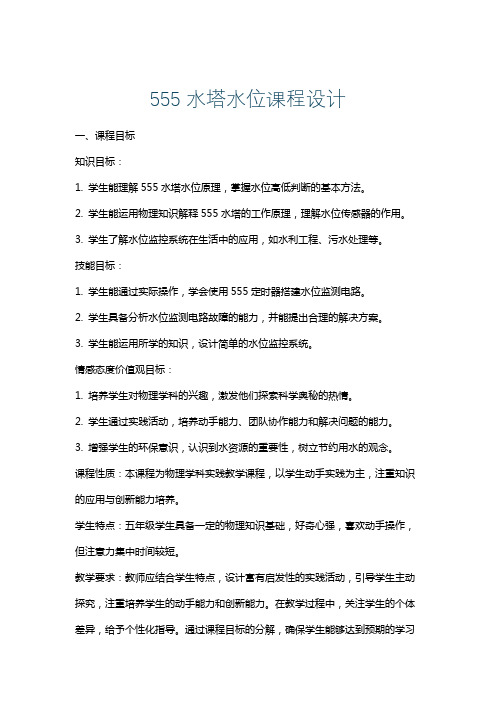
555水塔水位课程设计一、课程目标知识目标:1. 学生能理解555水塔水位原理,掌握水位高低判断的基本方法。
2. 学生能运用物理知识解释555水塔的工作原理,理解水位传感器的作用。
3. 学生了解水位监控系统在生活中的应用,如水利工程、污水处理等。
技能目标:1. 学生能通过实际操作,学会使用555定时器搭建水位监测电路。
2. 学生具备分析水位监测电路故障的能力,并能提出合理的解决方案。
3. 学生能运用所学的知识,设计简单的水位监控系统。
情感态度价值观目标:1. 培养学生对物理学科的兴趣,激发他们探索科学奥秘的热情。
2. 学生通过实践活动,培养动手能力、团队协作能力和解决问题的能力。
3. 增强学生的环保意识,认识到水资源的重要性,树立节约用水的观念。
课程性质:本课程为物理学科实践教学课程,以学生动手实践为主,注重知识的应用与创新能力培养。
学生特点:五年级学生具备一定的物理知识基础,好奇心强,喜欢动手操作,但注意力集中时间较短。
教学要求:教师应结合学生特点,设计富有启发性的实践活动,引导学生主动探究,注重培养学生的动手能力和创新能力。
在教学过程中,关注学生的个体差异,给予个性化指导。
通过课程目标的分解,确保学生能够达到预期的学习成果,为后续教学设计和评估提供依据。
二、教学内容本节教学内容主要包括以下三个方面:1. 555水塔水位原理:讲解555定时器的工作原理,引导学生理解水位传感器如何将水位高低转化为电信号,进而控制555定时器输出高低电平。
- 教材章节:第五章《电子电路》第三节《555定时器及其应用》- 内容安排:通过图示和实物展示,让学生直观地了解555定时器的内部结构和水位传感器的工作原理。
2. 水位监测电路搭建与调试:指导学生动手搭建555水塔水位监测电路,学会使用仪器和工具,并能对电路进行调试。
- 教材章节:第五章《电子电路》第四节《电路的搭建与调试》- 内容安排:学生分组进行实践活动,教师巡回指导,解答学生在操作过程中遇到的问题。
水塔水位控制系统设计精品

控制算法设计
根据水塔的实际情况和用户 需求,设计合适的控制算法 ,如PID控制、模糊控制等 ,实现对水位的精确控制。
执行机构选择
根据控制算法的要求,选择 合适的执行机构,如水泵、 阀门等,实现对水位的调节 。
通信与监控
建立水塔水位控制系统的通 信与监控网络,实现远程监 控、数据采集和故障预警等 功能。
防洪抗旱 在洪水或干旱时期,水塔水位控 制系统可发挥调节作用,减轻灾 害损失,保障人民生命财产安全 。
农业灌溉
在农业灌溉领域,水塔水位控制 系统能够根据土壤湿度和作物需 水情况,自动调节灌溉水量,提 高水资源利用效率。
工业冷却水供应
在工业生产中,水塔水位控制系 统可为冷却设备提供稳定的水源 ,确保设备正常运行,降低能耗 。
重要性
水塔水位控制系统对于保证供水系统 的稳定运行具有重要意义,能够避免 因水位过高或过低对供水系统造成的 影响,提高供水效率和水质安全。
水塔水位控制系统的历史与发展
历史
水塔水位控制系统最初采用人工 控制方式,随着技术的发展,逐 渐演变为自动化控制系统。
发展
现代水塔水位控制系统不断引入 新技术和智能化设备,如传感器 、PLC控制器、变频器等,实现 更加精准和高效的控制。
数据处理
对采集到的数据进行预处理和分析,为控制 算法提供准确可靠的数据支持。
安全保护机制的建立
权限管理
设置不同等级的用户权限,确保只有授权用户才能进行相应的操作。
异常处理
当出现异常情况时,系统能够及时报警并采取相应的安全措施,如自动关闭阀门、启动 备用设备等。
05
CATALOGUE
水塔水位控制系统的调试与优化
标准化与模块化
为便于系统的集成、互换和维护,水塔水位控制系统将逐步实现标准 化和模块化设计。
水塔水位检测与抽水自动控制系统的设计_刘杰
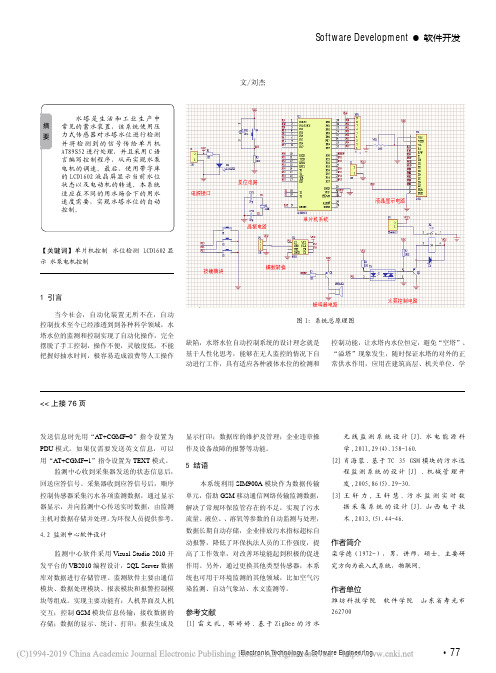
Software Development ·软件开发Electronic Technology & Software Engineering 电子技术与软件工程• 77发送信息时先用“AT+CGMF=0”指令设置为PDU 模式。
如果仅需要发送英文信息,可以用“AT+CGMF=1”指令设置为TEXT 模式。
监测中心收到采集器发送的状态信息后,回送应答信号。
采集器收到应答信号后,顺序控制传感器采集污水各项监测数据,通过显示器显示,并向监测中心传送实时数据,由监测主机对数据存储并处理。
为环保人员提供参考。
4.2 监测中心软件设计监测中心软件采用Visual Studio 2010开发平台的VB2010编程设计,SQL Server 数据库对数据进行存储管理。
监测软件主要由通信模块、数据处理模块、报表模块和报警控制模块等组成。
实现主要功能有:人机界面及人机交互;控制GSM 模块信息传输;接收数据的存储;数据的显示、统计、打印;报表生成及显示打印;数据库的维护及管理;企业违章操作及设备故障的报警等功能。
5 结语本系统利用SIM900A 模块作为数据传输单元,借助GSM 移动通信网络传输监测数据,解决了常规环保监管存在的不足,实现了污水流量、液位、、溶氧等参数的自动监测与处理,数据长期自动存储,企业排放污水指标超标自动报警,降低了环保执法人员的工作强度,提高了工作效率,对改善环境能起到积极的促进作用。
另外,通过更换其他类型传感器,本系统也可用于环境监测的其他领域,比如空气污染监测、自动气象站、水文监测等。
参考文献[1]雷文礼,邵婷婷.基于ZigBee 的污水无线监测系统设计[J].水电能源科学,2011,29(4).158-160.[2]肖海蓉.基于TC 35 GSM 模块的污水远程监测系统的设计[J] .机械管理开发,2005,86(5).29-30.[3]王轩力,王轩慧.污水监测实时数据采集系统的设计[J].山西电子技术,2013,(5).44-46.作者简介栾学德(1972-),男,讲师,硕士。
水塔水位监测方案说明
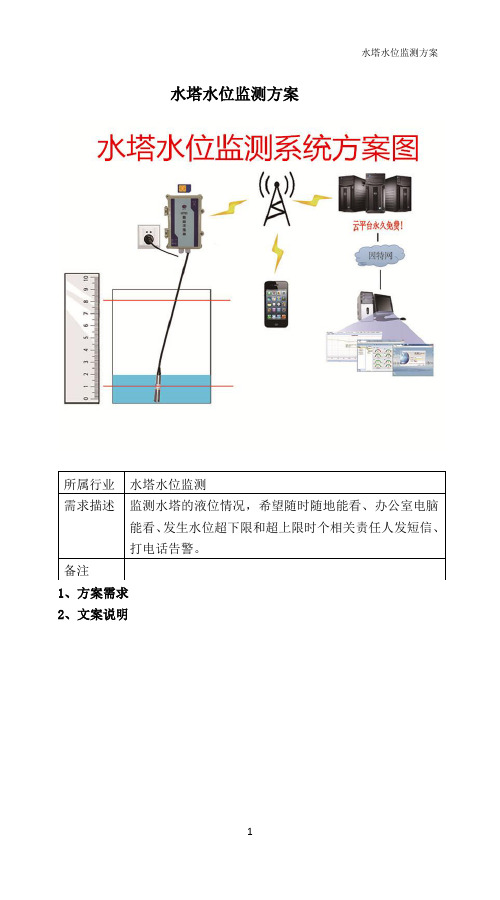
水塔水位监测方案
1、方案需求
2、文案说明
(1)系统简介
本方案采用模拟量转GPRS模块(以下简称GPRS模块)和4~20mA 型液位变送器(客户自备)组成系统,液位变送器将液位信号传给GPRS 模块,GPRS模块可应答短信查询水位、在水位超限时短信报警、电话语音报警、数据实时上传云平台的功能。
只需要在液位超上下限时进行短信报警、电话语音报警的客户不需要借助任何软件即可实现所需功能。
需要实现手机、电脑随时随地看数据的客户可通过云平台查看实时水位状态,云平台完全中性、永久免费并提供免费app(安卓)。
(2)系统特点
①只需要一张手机卡即可实现对水位的监测,月流量小于30M(5元/月),不连接云平台的客户不需要流量
②交流220V供电,灵活方便
③云平台完成记录液位曲线
④可短信查看、app查看当前液位
⑤超上下限时可对多人进行短信报警、电话语音报警。
- 1、下载文档前请自行甄别文档内容的完整性,平台不提供额外的编辑、内容补充、找答案等附加服务。
- 2、"仅部分预览"的文档,不可在线预览部分如存在完整性等问题,可反馈申请退款(可完整预览的文档不适用该条件!)。
- 3、如文档侵犯您的权益,请联系客服反馈,我们会尽快为您处理(人工客服工作时间:9:00-18:30)。
摘要随着社会的发展高楼逐渐变成了人们的居所,而高楼供水日渐成为人们日常生活中的一个问题,而水塔成为人们供水的首要选择。
本文结合水塔的设计,供给水的需求,主要解决水塔的持续供水和水位、水压的检测。
我们主要用传感器对其信号的收集,转换为相应的电信号。
从而来控制抽水泵和加压水泵的工作来达到给居民楼于恒压不断水的供给。
解决高楼的水压水量不足给人们日常生活带来不便的问题。
水位控制在日常生活及工业领域中应用相当广泛,比如水塔、地下水、水电站等情况下的水位控制。
自动检测水位的检测系统能根据水位变化的情况自动调节。
本设计采用PLC进行主控制,利用传感器测量水位的变化,把测量到的水位变化转换成相应的电信号,用A/D转换器对接收到的信号进行数据处理,完成水位的检测、控制及故障报警。
该设计主要集合了PLC的应用、传感器的应用和数模转换的应用等;通过对学科知识的一个集合来构造此设计,从而来提高自己的构思能力,同时是对自己所学的知识的一个检阅;对所学科目的一个总体构思。
关键词:水位、传感器、PLCAbstractWith the development of building society gradually into people's homes and buildings, water supply is becoming a problem in people's daily life, and becomes the first choice of the people of water tower. In this paper, combined with the tower design, the water supply demand, mainly to solve the continuous water supply and water level detection, the pressure of the water tower. We mainly used to collect sensor to the signal, is converted to a corresponding electrical signal. In order to control the water pump and the pressure pump to work to give residents in constant pressure water supply. To solve the problem of pressure water tower to people's daily life inconvenient problem.Water level control is widely used in daily life and industrial fields, such as the water level of the water tower, water, hydropower station under the condition of control. Automatic detection system of water level can be automatically adjusted according to water level changes. This design uses PLC for the main control, sensor using the change water level measurement, the measured water level to change into a corresponding electrical signal by A/D converter, the received signal and data processing, the water level detection, control and fault alarm completed.The design of the main set of applications and data model application, sensor PLC conversion applications; through a set of subject knowledge to construct this design, so as to improve their thinking ability, also is a parade of his knowledge; to have an overall idea of the subject。
Keywords: water level, sensor, PLC目录第一章传感器的概述 (1)第一节传感器的的作用与功能 (1)第二节传感器的分类 (1)第三节传感器的主要静态性能指标 (2)第四节水位传感器的原理及应用 (3)第二章 PLC可编程控制器的介绍 (5)第一节可编程控制器 (5)第二节 PLC的结构及其各部分的作用................ 错误!未定义书签。
第三节 PLC的工作原理 (7)第三章模数转换的概述与应用 (8)第一节模数转换的概念 (8)第二节模数转换的过程 (8)第四章水塔水位的检测 (9)第一节水塔水位的检测的构成和工作过程 (9)第二节 PLC控制器的选择和端口分布 (10)第三节水塔水位的控制程序 (11)结束语 (13)谢辞 (14)参考文献 (15)第一章传感器的概述第一节传感器的的作用与功能传感器的定义是:能感受规定的被测量并按照一定的规律转换成可用输出信号的器件或装置,通常由敏感元件和转换元件组成。
其中,敏感元件是指传感器中能直接感受或响应被测量的部分;转换元件是指传感器中能将敏感元件或响应的被测量转换成适合于传感器或测量的电信号部分。
对于传感器的定义与传感器技术的内涵,传感器应当从三个方面来理解把握,即(1)传感器的作用——体现在测量上。
获取被测量,是应用传感器的目的,也是本设计的体现。
(2)传感器的工作原理——体现在其敏感元件上。
敏感元件是传感器技术的核心,也是研究、设计和制作传感器的关键。
(3)传感器的输出信号形式——体现在其适于传输或测量的电信号上。
输出信号时需要解决非电量向电信号转换以及不适于传输或测量的微弱电信号向适于传输与测量的可用的电信号转换的技术问题,,反应了传感器技术在自动化技术领域的时代性。
第二节传感器的分类一、按工作原理分类传感器按其敏感的工作原理,一般可分为物理型、化学型、和生物型三大类,如图下图所示。
结构型传感器物理型传感器物性型传感器传感器化学型传感器生物型传感器物理型传感器是利用某些敏感元件的物理性质或某些功能材料的特殊物理性能制成的传感器。
如利用金属材料在被测量作用下引起的电阻变化的应变效应的应变式传感器;利用半导体材料在被测量作用下引起的电阻值变化的压阻效应制成的压阻式传感器;利用电容器在被测量的作用下引起电容值的变化制成的电容式传感器等。
物理型传感器又可以分为结构型传感器和物性型传感器。
结构型传感器是以结构为基础,利用某些物理规律来感受(敏感)被测量,并将其转换为电信号实现测量的。
例如电容式压力传感器,谐振式压力传感器等;物性型传感器就是利用某些功能材料本身所具有的内在特性及效应感受(敏感)别测量,并转换成可用电信号的传感器。
例如压电式压力传感器等。
化学传感器是利用电化学反应原理,把无机或有机化学的物质成分、浓度等转换为电信号的传感器。
最常用的是离子敏传感器,即利用离子选择性电极,测量溶液的PH值或某些离子的浓度,如钾离子,钠离子等。
生物传感器是近年来发展很快的一类传感器。
它是利用生物活性物质选择性来识别和测定生物化学物质的传感器。
它由两大部分组成。
其一是功能识别物质,其作用是对被测物质进行识别。
其二是电、光信号转换装置,此装置的作用是把在功能膜上进行的识别被测物所产生的化学反应转换成便于传输的电信号或光信号。
二、按被测量分类按传感器的被测量——输入信号分类,能够很方便地表示传感器的功能,也便于用户使用。
按这种分类方法,传感器可以分为温度、压力、流量、物位、加速度、速度、位移、转速、力矩、湿度、粘度、浓度等传感器。
生产厂家和用户都习惯于这种分类方法。
第三节传感器的主要静态性能指标在检测控制系统和科学实验中,需要对各种参数进行检测和控制,而要达到比较优良的控制性能,则必须要求传感器能够感测被测量的变化并且不失真地将其转换为相应的电量,这种要求主要取决于传感器的基本特性。
传感器的基本特性主要分为静态特性和动态特性。
一、反映传感器静态特性的性能指标静态特性是指检测系统的输入为不随时间变化的恒定信号时,系统的输出和输入入之间的关系。
主要包括线性度、灵敏度、迟滞、重复性、漂移等。
(1) 线性度:指传感器输出量与输入量之间的实际关系曲线偏离拟合直线的程度。
(2) 灵敏度:灵敏度是传感器静态特性的一个重要指标。
其定义为输出量的增量与引起该增量的相应输入量增量之比。
灵敏度越大,表示传感器越灵敏.。
(3) 重复性:重复性是指传感器在输入量按同一方向作全量程连续多次变化时,所得特性曲线不一致的程度。
(4) 测量范围传感器所能测量到的最小输入量与最大输入量之间的范围称为传感器的测量范围。
(5) 量程传感器测量范围的上限值与下限值的代数差,称为量程。
(6) 精度传感器的精度是指测量结果的可靠程度,是测量中各类误差的综合反映,测量误差越小,传感器的精度越高。
(7) 稳定性稳定性表示传感器在一个较长的时间内保持其性能参数的能力。
二、反映传感器动态特性的性能指标动态特性是指检测系统的输入为随时间变化的信号时,系统的输出与输入之间的关系。
主要动态特性的性能指标有时域单位阶跃响应性能指标和频域频率特性性能指标。
第四节水位传感器的原理及应用前几章我们主要解决了对传感器的认识及讲解,对传感器的工作原理、应用、指标等的详细概况进行了了解和认识,通过对前面的熟悉能更好的对此设计进行阅读。
此章节我们来介绍此设计的核心元件水位传感器。
通过的它的原理及应用的描述来用它对此设计进行设计。
一、水位传感器原理容器内的水位传感器,将感受到的水位信号传送到控制器,控制器内的计算机将实测的水位信号与设定信号进行比较,得出偏差,然后根据偏差的性质,向给水电动阀发出"开""关"的指令,保证容器达到设定水位。
二、作用用途投入式水位传感器适用于石油化工、水利、电力、制药、供排水、环保等系统和行业的各种介质的水位测量。
